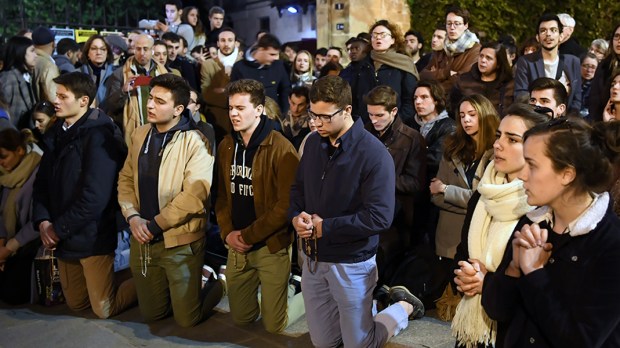A devastating fire ripped through Notre Dame Cathedral in Paris Monday evening, destroying two thirds of the roof and causing the spire to collapse. But the main structure, including the two towers fronting the Gothic church, appear to have been spared.
French President Emmanuel Macron vowed to rebuild the UNESCO world heritage landmark.
The fire, which raged for four or five hours, creating an apocalyptic scene visible throughout much of Paris, appears to have stayed above the vaulted ceiling. Apparently, only a small part of the vault collapsed.
A reporter for the Paris daily Le Monde, Raphaelle Bacque, said the interior was largely preserved, with the main altar and the walls intact. The great rose windows may have survived, though the smaller circular windows above them in the north and south transept are probably gone.
The Paris fire chief, Jean-Claude Gallet, said around 11 p.m. Paris time, about four hours after the fire began, that the structure had been “saved and preserved as a whole.”
No one was reported killed in the blaze, which began just around the cathedral’s normal closing time for the day. One of the nearly 500 firefighters responding to the fire, however, was reported to be seriously injured.
“The worst has been avoided, even though the battle is not completely won,” Macron said in a brief speech at Notre Dame Monday night. “This history is ours. It is burning. I say to you very solemnly tonight, this cathedral, we will rebuild it.”
The 850-year-old structure was already undergoing a nearly $7 million restoration project to address a number of unsafe conditions. There was initial speculation that the fire may have started as a result of that restoration—perhaps because a blow torch or sparks from a welder got too close to very dry, centuries-old timber inside. André Finot, a spokesman for the cathedral, said the fire started in the cathedral’s “attic.”
But it was too early to draw any conclusions. The Parisian prosecutor’s office said it launched an inquiry into the fire within an hour of its start.
Fighting church fires is often a challenge, due to the vast space that provides an abundance of oxygen, and Notre Dame was no exception. Water streams from fire hoses could barely reach the top of the building. Dropping water from airplanes was ruled out, as such a move could have seriously compromised the structure.
The fire broke out around 6:50 p.m. Paris time—shortly after the church closed for the day. The New York Times quoted witnesses as saying that the doors of the cathedral were abruptly shut without explanation as a few straggling tourists were trying to get in. “Within moments, tiny bits of white smoke started rising from the spire—which, at 295 feet, was the highest part of the cathedral,” the newspaper said:
Billowing out, the smoke started turning gray, then black, making it clear that a fire was growing inside the cathedral, which is currently covered in scaffolding. Soon, orange flames began punching out of the spire, quickly increasing in intensity. The French police rushed in and started blowing whistles, telling everyone to move back, witnesses said. By then, the flames were towering, spilling out of multiple parts of the cathedral. Tourists and residents alike came to a standstill, pulling out their phones to call their loved ones. Older Parisians began to cry, lamenting how their national treasure was quickly being lost.
About an hour after the fire began, the spire collapsed. Macron, who canceled a televised speech he was to make about recent protests in France, rushed to the scene of the fire. “Thoughts go out to all Catholics and all French people. Like all our compatriots, I am sad tonight to see this part of us burning,” he said on Twitter.
Macron went straight into meetings at the nearby Paris police headquarters.
There was a roof collapse at 8:07 p.m.
The mayor of Paris, Anne Hidalgo, said that some of the cathedral’s cherished artworks had been taken out and were being put in safe storage.
Aleteia reported last night that the precious relics that King Louis IX had brought back from the Byzantine Empire in 1238—fragments of the True Cross and the Crown of Thorns—were taken to safety as the fire began.
The fire drew worldwide attention and reaction from scores of world and religious leaders. The Vatican issued a statement saying, “The Holy See has seen with shock and sadness the news of the terrible fire that has devastated the Cathedral of Notre Dame, symbol of Christianity in France and in the world.”
Archbishop Wilton D. Gregory of Atlanta, recently named archbishop of Washington, D.C., stated: “This iconic church is a bookmark of history and a sacred place where Catholics have prayed for almost 9 centuries. The Church of the Archdiocese of Atlanta sends our French brothers and sisters our prayers and closeness in faith. May the Lord’s Passion, Death, and Resurrection strengthen them as we celebrate these mysteries this week. May Mary, the Mother of God, bless Paris and all those who hold this church as an icon of faith.”
Philadelphia Archbishop Charles Chaput called Notre Dame a “testament to man’s desire to glorify God on earth and a beacon of hope for millions of pilgrims each year.”
By the end of the day, with talk of soliciting donations for what is sure to be a major rebuilding project, French billionaire François-Henri Pinault said he and his family will donate 100 million euros. Pinault is chairman and CEO of the international luxury group Kering, which includes Gucci and Saint Laurent, and president of the French holding company Groupe Artémis, which owns the fine arts auction house Christie’s.

